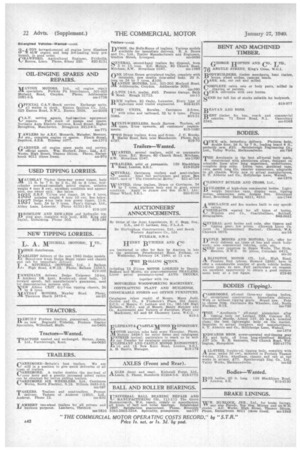Would Record-breaking improve the Breed of the Oil Engine ?
Page 44

If you've noticed an error in this article please click here to report it so we can fix it.
Record-breaking, as Opposed Jo Racing, as a Means For Research and Development of the Oil Engine as Used in the Commercial Vehicle Field
'THERE is a. well-knct baying to 1 the effect that: The racing car of to-day is the touring car. of, to-t morrow," and this is based Orf the lessons which raring 'has 'handed on tO designers of utility Ears and -the consequent speeding-up of progress in the private-car field, There seems no reason why a similar slogan, such as: " The record-holding .oil engine of to-day is the successful commercialvehicle engine of the future," should not ring true.
The oil engine has made notable progress in its application to road vehieles, and manufacturers of this class Of engine are, in many cases, turning to the light commercial vehicle as a means for widening the scope of the modern, high-speed oil engine of moderate size.
It seems likely that considerable development will be seen in this direction in the immediate future and that, as engines developed for use in the lighter commercial vehicles approach closer and Closer to the petrol enginein matters of weight, power and flexibility, so will the private-car market open up to them.
Record-attacking Not Racing.
I can see no good reason why those designers and engineers, striving further to improve the light oil engine, should not derive the same benefits from racing that the petrol-engine technicians have -done in the past. Actually, reccrd-attacking, rather than racing, would seem the best competitive medium for oil-engine research and advertisement at the present stage of development. Records may be attempted at any time to suit the contender, and, consequently, there is not the same anxiety, as there so oftern,,is in racing, when vehicles are -often, run in a hurriedly prepared condition.
Another point in favour of recordbreaking is that any reasonable chassis is10 may be used for installation of the racing engine, provided that the finaldrive • ratio suits the characteristics of the power unit. Racing, as practised to-rky, calls for excellent braking, steering and -road-holding qualities,
Thus, the record-breaking vehicle will-be, cheaper tO build and will leave the designer free to .cnncentrate -on engine development. Moreover, commercial-vehicle operators are used to grappling with statistics, and figures relating to officially timed record attacks will mean more to them than the result of a spectacular take.
Official Recognition.
The A.I.A.C.R., the international governing body of motor racing, recognized the growing popularity of the high-speed oil engine and, in 1035, introduced a -separate record category
for compression,ignition engined. vehicles. The first records to be broken in this category were made by R. J. Munday, who installed a 2.7-litre Perkins Wolf oil engine in a racing Thomas-Special chassis. He took -records up to 100 miles at speeds of 88 m.p.h. -to 89 m.p.h., and, with the aid of a Zoller supercharger, covered the flying kilometre at 94.7 m.p.h. The 85 mm, by 120.6 mm. engine weighed 624 lb. and measured 2 ft. 9 ins. by '2 ft, 4 ins., and, for the attempt, it was boosted up from 45 b.h.p. to 'M b.h.p.
Apart from any lesson8 learned, there is little doubt that this record attack added much to the prestige
enjoyed liv yerkins engines, whilst it eriiphasi.red to private-car users the Possibilities of the oil engine, particularly as this small unit, at racing -speeds, gave 30 m.p.g. on a fuel costing only 1s, Id. per gallon, Before the A.I.A,C.R, recognized a separate class for oil engines, a Yacc6 oil-engined car 'had broken records in the ordinary way, whilst Capt. George Eyston, in 1933, demonstrated his saloon racing car with an A.E:C. oil engine to a gathering of prominent per
sons at BrOoklands. This . car was equipped with a practically standard A.E.C. bus engine and, later, it became the first oiler to exceed 120. m.p.h.
existing Records.
To-day Capt. Eyston holds all the records in the compression-ignition category, up to 24 hours, with his A.E.C.-engined cars. His Flying Spray holds the fastest of these records at 159.1 m.p.h., the average speed for the two-way flying kilometre, for which run the car was talten over to Utah, U.S.A. The remaining records, up -to eight days, are held by a 1.7-litre Yacce> at speeds around 70 m.p.h.
In view of ihe growing interest in the smaller forms of oil engine, these latter records, along with Munday's 5litre records of 1935, are of considerable importance. This suggests that the time is ripe for the A.I.A.C.R. to introduce simple capacity distinctions into the compression-ignition record category, otherwise cars with engines of large capacity will occupy the class. Capt. Eyston's cars are, obviously, far faster than the Yacco by virtue of an engine capacity of over 9 litres.
Given this suggested subdivision of the category, record attacking exists as a valuable 'medium fof research to the oil-engine manufacturer, and, in addition, constitutes a useful means for enhancing oil,erigine prestige. W.B.




















































































